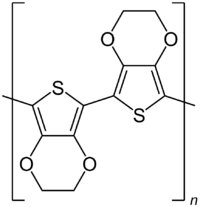Chemistry:Poly(3,4-ethylenedioxythiophene)
Poly(3,4-ethylenedioxythiophene) (PEDOT or PEDT; IUPAC name poly(2,3-dihydrothieno[3,4-b][1,4]dioxane-5,7-diyl)) is a conducting polymer based on 3,4-ethylenedioxythiophene or EDOT. It was first reported by Bayer AG in 1989.[1]
Polymer
PEDOT possesses many advantageous properties compared to earlier conducting polythiophenes like 3-alkylthiophenes. For example, the polymer is optically transparent in its conducting state and has high stability, moderate band gap, and low redox potential.[2][3] Its major disadvantage is its poor solubility, which is partly circumvented by use of composite materials such as PEDOT and PEDOT-TMA.
The polymer is generated by oxidation. The process begins with production of the radical cation of EDOT monomer, [C2H4O2C4H2S]+. This cation adds to a neutral EDOT followed by deprotonation. The idealized conversion using peroxydisulfate is shown:
- n C2H4O2C4H2S + n (OSO3)22− → [C2H4O2C4S]n + 2n HOSO3−
Polymerization is usually conducted in the presence of polystyrene sulfonate (PSS), which acts as a template. PSS also provides a counter ion, which balances the charges in the reaction and hinders the formation of by-products such as 3,4-ethylenedioxy-2(5H)-thiophenone, and keeps the PEDOT monomers dispersed in water or aqueous solutions. [4] The resulting PEDOT:PSS composite can be deposited on a conductive support such as platinum, gold, glassy carbon, and indium tin oxide.[5]
Uses
Applications of PEDOT include electrochromic displays and antistatics.[6]
PEDOT has also been proposed for photovoltaics, printed wiring, and sensors.[6][4] PEDOT has been proposed for use in biocompatible interfaces.[7][8]
Further reading
- Bello, A.; Giannetto, M.; Mori, G.; Seeber, R.; Terzi, F.; Zanardi, C. (2007). "Optimization of the DPV Potential Waveform for Determination of Ascorbic Acid on PEDOT-Modified Electrodes". Sensors and Actuators B: Chemical 121 (2): 430. doi:10.1016/j.snb.2006.04.066.
- Kumar, S. Senthil; Mathiyarasu, J.; Phani, K. L. N.; Yegnaraman, V. (2005). "Simultaneous Determination of Dopamine and Ascorbic Acid on Poly(3,4-ethylenedioxythiophene) Modified Glassy Carbon Electrode". Journal of Solid State Electrochemistry 10 (11): 905. doi:10.1007/s10008-005-0041-7.
- Zhang, Xinyu; MacDiarmid, Alan G.; Manohar, Sanjeev K. (2005). "Chemical Synthesis of PEDOT Nanofibers". Chemical Communications (42): 5328–30. doi:10.1039/b511290g. PMID 16244744.
References
- ↑ Friedrich Jonas, Gerhard Heywang, Werner Schmidtberg, Jürgen Heinze, Michael Dietrich, "Polythiophenes, Process for Their Preparation and Their Use", EP patent Patent 0339340A2, published 1989-11-02, issued 1999-12-29, assigned to BAYER AG
- ↑ Groenendaal, L.; Zotti, G.; Aubert, P.-H.; Waybright, S. M.; Reynolds, J. R. (5 June 2003). "Electrochemistry of Poly(3,4-alkylenedioxythiophene) Derivatives". Advanced Materials 15 (11): 855–879. doi:10.1002/adma.200300376.
- ↑ Heywang, Gerhard; Jonas, Friedrich (1992). "Poly(alkylenedioxythiophene)s—New, Very Stable Conducting Polymers". Advanced Materials 4 (2): 116–118. doi:10.1002/adma.19920040213.
- ↑ 4.0 4.1 Kirchmeyer, S.; Reuter, K. (2005). "Scientific Importance, Properties and Growing Applications of Poly(3,4-Ethylenedioxythiophene)". J. Mater. Chem. 15 (21): 2077–2088. doi:10.1039/b417803n.
- ↑ Sun, Kuan; Zhang, Shupeng; Li, Pengcheng; Xia, Yijie; Zhang, Xiang; Du, Donghe; Isikgor, Furkan Halis; Ouyang, Jianyong (July 2015). "Review on Application of PEDOTs and PEDOT:PSS in Energy Conversion and Storage Devices". Journal of Materials Science: Materials in Electronics 26 (7): 4438–4462. doi:10.1007/s10854-015-2895-5.
- ↑ 6.0 6.1 Groenendaal, L. B.; Jonas, F.; Freitag, D.; Pielartzik, H.; Reynolds, J. R. (2000). "Poly(3,4-Ethylenedioxythiophene) and Its Derivatives: Past, Present, and Future". Adv. Mater. 12 (7): 481–494. doi:10.1002/(SICI)1521-4095(200004)12:7<481::AID-ADMA481>3.0.CO;2-C.
- ↑ Donahue, Mary J.; Sanchez-Sanchez, Ana; Inal, Sahika; Qu, Jing; Owens, Roisin M.; Mecerreyes, David; Malliaras, George G.; Martin, David C. (1 April 2020). "Tailoring PEDOT Properties for Applications in Bioelectronics" (in en). Materials Science and Engineering: R: Reports 140: 100546. doi:10.1016/j.mser.2020.100546. ISSN 0927-796X.
- ↑ Cuthbertson, Anthony (17 August 2020). "Material found by scientists 'could merge AI with human brain'" (in en). The Independent. https://www.independent.co.uk/life-style/gadgets-and-tech/news/artificial-intelligence-brain-computer-cyborg-elon-musk-neuralink-a9673261.html.
 |


